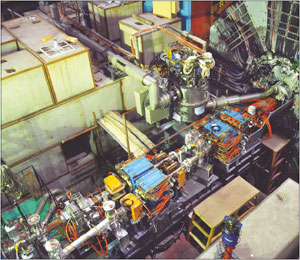Champagne-bottle corks popped early on the morning of 20 July, as researchers at the Institute of High Energy Physics (IHEP) in Beijing celebrated the observation of the first particle collisions in the upgraded Beijing Electron Positron Collider (BEPC II) and the new Beijing Spectrometer, BES III. Although BEPC II and BE III had already been carefully tested separately, this was the first time that they had operated together.

Image credit: BES III/IHEP.
The first collisions, occurring late the previous afternoon, represent a new milestone for the project, which was nearly four years in planning and took another four and half years to construct. When fully operational, the BEPC II/BES III complex will be the world’s premier facility for studying properties of charmed mesons and τ leptons.
BEPC II is a major upgrade of IHEP’s previous e+e– collider, BEPC. The major change has been the addition of a second ring of magnets that allows the electron and positron beams to be stored separately. In the original machine, the electrons and positrons shared the same vacuum tube in a single ring of magnets, which limited the intensities of each beam and, therefore, the luminosity. The two separate rings of BEPC II will allow 93 bunches of electrons to collide with 93 bunches of positrons, with an expected increase in collision rate of more than 100-fold. Other improvements include a more powerful injection linac for electrons and positrons, and extensive use of superconducting technology, both for the RF-accelerating cavities and for the magnetic final focusing of the stored beams as they enter the interaction region.

The linac upgrade was finished in late 2004 and quickly reached its design goals. With the exception of the conventional focusing magnets in the interaction region, construction of the double rings was completed in October 2006. Beams were first stored the following month and synchrotron radiation running commenced soon after. The first collisions using conventional final-focus magnets were produced in March 2007 and collisions with the superconducting final-focus magnets followed in November, achieving 500 mA on 500 mA beam–beam collisions with a luminosity higher than 1 × 1032 cm–2s–1.
The assembly of the BES III detector was completed in January 2008 and it was moved into the interaction region in early May. A major improvement in this detector over its predecessor, BES II, is the huge superconducting solenoid magnet with a central field of 1 T. This magnet – the most powerful magnet in China – was built at IHEP by the laboratory’s research staff. Together with the new helium gas-based tracking chamber, it provides a factor of five improvement in charged-particle momentum resolution over BES II. In addition, BES III contains an array of 6240 caesium iodide crystals to measure the energies of high-energy electrons and gamma rays. The crystal calorimeter provides more than a factor of 10 improvement in the precision of measurements of electromagnetic shower energies.
To handle the huge, LHC-scale data rates expected when BES III operates at the J/ψ peak, the team has developed a specialized state-of-the-art, high-speed data-communication system. The figure shows an event display of the first candidate charmed-meson pair event in BES III, demonstrating that the detector and its associated software are performing well.
During the Saturday-night/Sunday-morning test run, operation of BEPC II proved stable, with a luminosity that hovered around 1030 cm–2s–1, about a factor of 1000 times below the project’s ultimate design goal of 1033 cm–2s–1. This was partly because the operators used a 1-bunch-on-1-bunch collision mode to limit the intensity of the beam currents, avoiding possible damage to the sensitive detection elements of the BES III spectrometer, while the team also made sure that everything worked as expected. The next day, 20-bunch-on-20-bunch operation was quickly established, with a much higher luminosity. So far the beam-associated radiation background in the detector is manageable, even with the increased currents. During the coming months the intensity of the beams will be gradually increased while BES III’s 2000 detection elements will be carefully adjusted and calibrated. When this process is completed, sometime in the early autumn, the BES III research programme will begin.
• BES III is run by a team from China, Hong Kong, Germany, Japan, Russia and the US.





